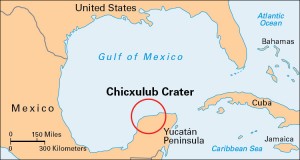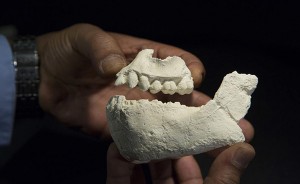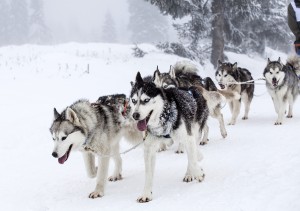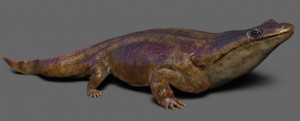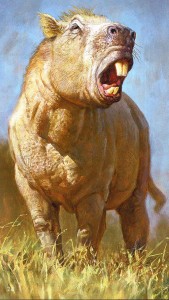To Become King: Be Smart, Be a Good Listener, Be Deadly
Wednesday, March 23rd, 2016March 23, 2016
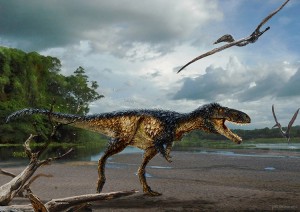
A recreation of a horse-sized tyrannosaur, Timurlengia euotica, stalks through its natural environment of 90 million years ago. Two other reptiles (Azhdarcho longicollis) fly nearby. The newly-discovered fossilized remains of a Timurlengia euotica reveal how Tyrannosaurus rex and its close relatives became top predators. Credit: © Todd Marshall (Smithsonian)
Rex means king, and, sure enough, Tyrannosaurus rex was the king. As top predator at the end of the age of dinosaurs, T. rex hunted down prey with its heightened senses and tore them apart with its powerful jaws. It wasn’t always like that, however. Tens of millions of years earlier, the smaller ancestors of T. rex cowered from other predators called allosaurs (like the well-known Allosaurus). Little is known about how ancestors of T. rex evolved (changed over time) from small, nimble hunters into the huge predators of the Late Cretaceous (80-66 million years ago). Last week, a team of paleontologists, led by Stephen Brusatte of Scotland’s University of Edinburgh, announced a discovery, Timurlengia euotica, that helps fill in this gap in the Tyrant Lizard King’s family tree. The paleontologists announced their findings in the journal Proceedings of the National Academy of Sciences.
Tyrannosaurus rex was a large, meat-eating dinosaur that lived about 68 to 65 million years ago in what is now western North America. It was one of the largest meat-eating dinosaurs, measuring about 40 feet (12 meters) long and about 12 feet (3.7 meters) high at the hip, and weighing about 7 short tons (6.3 metric tons). Similar animals roamed Asia and Europe. These monsters were the last of a group of meat-eating dinosaurs called tyrannosaurs, which came into existence some 150 million years ago.
Unlike the giant T. rex, most early tyrannosaurs were modestly sized hunters. They probably had hairlike feathers for warmth, camouflage, and display. Timurlengia reveals tyrannosaurs’ humble origins, but it also hints at their future dominance. It was a horse-sized tyrannosaur that lived in what is now Uzbekistan some 90 million years ago. The dinosaur is named for Timur (sometimes called Tamerlane, as in a poem by Edgar Allan Poe), a conqueror who ruled that region with an iron fist from the late 1300’s through the early 1400’s. Its specific name, euotica, references its keen sense of hearing. While Brusatte’s team only found a little over a dozen fragments of Timurlengia’s skeleton, some of these pieces contained a large inner ear, similar to later giant tyrannosaurs like T. rex. The fragments revealed that the dinosaur had a relatively large brain, also like its later cousins. Apparently, tyrannosaurs had all the smarts and sensory equipment to become top predators 90 million years ago, but they still lived in the shadow of the more primitive allosaurs.
At some point 80 to 90 million years ago, the allosaurs were replaced as apex predators by the tyrannosaurs, which eventually reached the giant proportions of T. rex. Although Stephen Brusatte and the team’s findings reveal that tyrannosaurs were already smart hunters with keen senses, it still isn’t known why exactly this change in dominant dinosaur occurred. Tyrannosaurs could have slowly replaced allosaurs because of their superior intelligence and senses. Or, an environmental disaster could have caused the allosaurs to go extinct, making room for the tyrannosaurs to thrive. More finds like Timurlengia will help scientists determine how tyrannosaurs emerged from the shadows to become the kings of the dinosaurs.

